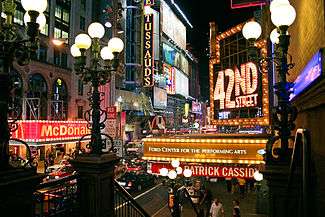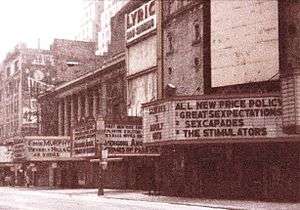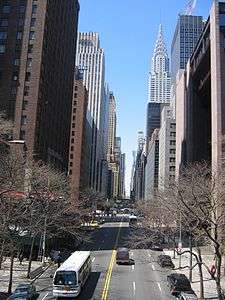42nd Street (Manhattan)
42nd Street is a major crosstown street in the New York City borough of Manhattan, running primarily in Midtown Manhattan and Hell's Kitchen. The street is the site of some of New York's best known buildings, including (east to west) the headquarters of the United Nations, Chrysler Building, Grand Central Terminal, New York Public Library Main Branch, Times Square, and the Port Authority Bus Terminal. The street is known for its theaters, especially near the intersection with Broadway at Times Square, and as such is also the name of the region of the theater district (and, at times, the red-light district) near that intersection.
| Lincoln Highway (west of Broadway) New 42nd Street (8th to 7th Avenues) | |
 Looking west along 42nd Street from Seventh Avenue in 2004, including a marquee for a revival of the musical 42nd Street | |
%26groups%3D_45109dab0e21348acfd1409f772748c85ec566b2.svg)
| |
| Maintained by | NYCDOT |
|---|---|
| Length | 2.0 mi[1] (3.2 km) |
| Location | Manhattan, New York City |
| Postal code | 10036, 10018, 10017, 10168 |
| West end | |
| East end | |
| North | 43rd Street (west of 1st Avenue) 48th Street (east of 1st Avenue) |
| South | 41st Street (west of 6th Avenue) 40th Street (6th to 5th Avenues) 41st Street (east of 5th Avenue) |
| Construction | |
| Commissioned | March 1811 |




History
Early history
During the American Revolutionary War, a cornfield near 42nd Street and Fifth Avenue was where General George Washington angrily attempted to rally his troops after the British landing at Kip's Bay, which scattered many of the American militiamen. Washington's attempt put him in danger of being captured, and his officers had to persuade him to leave. The rout eventually subsided into an orderly retreat.[2]
John Jacob Astor purchased a 70 acres (28 ha) farm in 1803 that ran from 42nd Street to 46th Street west of Broadway to the Hudson River.[3]
19th century
The street was designated by the Commissioners' Plan of 1811 that established the Manhattan street grid as one of 15 east-west streets that would be 100 feet (30 m) in width (while other streets were designated as 60 feet (18 m) in width).[4]
In 1835, the city's Street Committee, after receiving numerous complaints about lack of access for development above 14th Street, decided to open up all lots which had already been plotted on the city grid up to 42nd Street, which thus became – for a time – the northern boundary of the city.[5]
Cornelius Vanderbilt began the construction of Grand Central Depot in 1869 on 42nd Street at Fourth Avenue as the terminal for his Central, Hudson, Harlem and New Haven commuter rail lines, because city regulations required that trains be pulled by horse below 42nd Street.[6] The Depot, which opened in 1871, was replaced by Grand Central Terminal in 1913.
Between the 1870s and 1890s, 42nd Street became the uptown boundary of the mainstream theatre district, which started around 23rd Street, as the entertainment district of the Tenderloin gradually moved northward.[7]
20th century
The corner of 42nd Street and Broadway, at the southeast corner of Times Square, was the eastern terminus of the Lincoln Highway, the first road across the United States, which was conceived and mapped in 1913.
Lloyd Bacon and Busby Berkeley's 1933 film musical 42nd Street, starring 30s heartthrobs Dick Powell and Ruby Keeler, displays the bawdy and colorful mixture of Broadway denizens and lowlifes in Manhattan during the Depression. In 1980, it was turned into a successful Broadway musical which ran until 1989, and which was revived for a four-year run in 2001.[8] In the words of the Al Dubin and Harry Warren title song, on 42nd Street you can find:
Little nifties from the Fifties, innocent and sweet,
Sexy ladies from the Eighties who are indiscreet,
They're side by side, they're glorified,
Where the underworld can meet the elite
Naughty, gawdy, bawdy, sporty, Forty-second Street!
From the late 1950s until the late 1980s, 42nd Street, nicknamed the "Deuce", was the cultural center of American grindhouse theaters, which spawned an entire subculture. The book Sleazoid Express, a travelogue of the 42nd Street grindhouses and the films they showed, describes the unique blend of people who made up the theater-goers:
depressives hiding from jobs, sexual obsessives, inner-city people seeking cheap diversions, teenagers skipping school, adventurous couples on dates, couples-chasers peeking on them, people getting high, homeless people sleeping, pickpockets...[9]
While the street outside the theatres was populated with:
phony drug salesman ... low-level drug dealers, chain snatchers ... [j]unkies alone in their heroin/cocaine dreamworld ... predatory chickenhawks spying on underage trade looking for pickups ... male prostitutes of all ages ... [t]ranssexuals, hustlers, and closety gays with a fetishistic homo- or heterosexual itch to scratch ... It was common to see porn stars whose films were playing at the adult houses promenade down the block. ... Were you a freak? Not when you stepped onto the Deuce. Being a freak there would get you money, attention, entertainment, a starring part in a movie. Or maybe a robbery and a beating.[9]
For much of the mid and late 20th century, the area of 42nd Street near Times Square was home to activities often considered unsavory,[10] including peep shows.
Revitalization
In the early 1990s, city government encouraged a cleanup of the Times Square area. In 1990, the city government took over six of the historic theatres on the block of 42nd Street between Seventh and Eighth Avenues, and New 42nd Street, a not-for-profit organization, was formed to oversee their renovation and reuse, as well as to construct new theatres and a rehearsal space.
In 1993, Disney Theatrical Productions bought the New Amsterdam Theatre, which it renovated a few years later. It is now the flagship for Disney's theatrical productions in New York.
Since the mid-1990s, the block has again become home to mainstream theatres and several multi-screen mainstream movie theatres, along with shops, restaurants, hotels, and attractions such as Madame Tussauds wax museum and Ripley's Believe It or Not that draw millions to the city every year. This area is now co-signed as "New 42nd Street" to signify this change.
Notable places
(from East to West):
- Headquarters of the United Nations, First Avenue
- Tudor City apartments, First Avenue
- Ford Foundation Building, between First and Second Avenues, former site of the Hospital for the Ruptured and Crippled (now known as the Hospital for Special Surgery)[11]
- News Building (formerly the New York Daily News Building), Second Avenue
- Chrysler Building, Lexington Avenue
- Socony–Mobil Building, Lexington Avenue
- Chanin Building, Lexington Avenue
- 110 East 42nd Street (formerly Bowery Savings Bank Building, now Cipriani S.A.), between Lexington and Park Avenues
- Pershing Square Building, Park Avenue
- Pershing Square, Park Avenue
- Grand Central Terminal, Park Avenue
- One Vanderbilt (planned), Vanderbilt Avenue
- 500 Fifth Avenue
- New York Public Library Main Branch, Fifth Avenue
- W. R. Grace Building, between Fifth and Sixth Avenues
- Salmon Tower Building, between Fifth and Sixth Avenues
- SUNY College of Optometry, between Fifth and Sixth Avenues
- Bryant Park, between Fifth and Sixth Avenues
- Shayne's Emporium, west of Sixth Avenue
- Bank of America Tower, Sixth Avenue
- Bush Tower, between Sixth and Seventh Avenues
- Times Square, Broadway and Seventh Avenue
- Times Square Tower, the building from which the ball drops on New Year's Eve, Broadway and Seventh Avenue
- American Airlines Theatre and New 42nd Street, between Seventh and Eighth Avenues
- Port Authority Bus Terminal, at Eighth Avenue
- 330 West 42nd Street, formerly McGraw-Hill Building, between Eighth and Ninth Avenues
- Holy Cross Church, between Eighth and Ninth Avenues
- Theatre Row, between Ninth and Eleventh Avenues
- Silver Towers apartments, at Eleventh Avenue
- Circle Line Sightseeing Cruises ferry terminal, Twelfth Avenue
Transportation
Subway
Every New York City Subway line that crosses 42nd Street has a stop on 42nd Street:[12]
- Times Square–42nd Street/Port Authority Bus Terminal (1, 2, 3, 7, <7>, A, C, E, N, Q, R, W, and S trains)
- 42nd Street/Fifth Avenue-Bryant Park (7, <7>, B, D, F, <F>, and M trains)
- Grand Central–42nd Street (4, 5, 6, <6>, 7, <7>, and S trains)
There are two subway lines under 42nd Street. The 42nd Street Shuttle (S train) runs under 42nd Street between Broadway/Seventh Avenue (Times Square) and Park Avenue (Grand Central). The IRT Flushing Line (7 and <7> trains) curves from Eleventh Avenue to 41st Street, under which it runs until Fifth Avenue; shifts to 42nd Street between Fifth and Madison Avenues; and continues under the East River to Queens. Each line stops at Times Square and Grand Central, though the Fifth Avenue station is also served by the 7 and <7> trains.[12]
In the past, every former IRT elevated line had a station at 42nd Street:
- 42nd Street on the IRT Second Avenue Line
- 42nd Street on the IRT Third Avenue Line
- 42nd Street on the IRT Sixth Avenue Line
- 42nd Street on the IRT Ninth Avenue Line
A fifth station extended over 42nd Street as a western spur from the Third Avenue Line to Grand Central Depot, later Grand Central Station, and finally Grand Central Terminal.
Bus
MTA Regional Bus Operations's M42 bus runs the length of 42nd Street between the Circle Line Sightseeing Cruises ferry terminal on the Hudson River and the headquarters of the United Nations on the East River.[13] Its predecessor, the 42nd Street Crosstown Line streetcar, had used 42nd Street. In 2019, bus lanes were installed along the length of the street.[14]
42nd Street is also used by several Staten Island express buses.[15]
In popular culture
- The George M. Cohan song "Give My Regards to Broadway" includes the lyrics "Tell all the gang at Forty-Second Street / That I will soon be there".
- The Jim Croce song "You Don't Mess Around with Jim" includes the lyrics "42nd street got Big Jim Walker, he a pool shootin' son of a gun..."
- The Billy Joel song "Miami 2017 (Seen the Lights Go Out on Broadway)" includes the lyrics "We'd seen it all the time on 42nd Street..."
- The Scorpions song "The Zoo" talks about the busy nightlife in New York; it includes the lyrics "Enjoy the Zoo, walk down 42nd Street".
- The Bleachers song "Goodmorning" references "the kids at 42" who helped him out at one point in his life.
- The Don McLean song "Sister Fatima" on American Pie mentions 42nd Street as a way to set the scene of New York in the 1960s.
- The title track of rapper Kurtis Blow's second album Deuce also refers to the street and its nightlife.
- The novel Our Lady of the Inferno is largely set against the backdrop of 1980s 42nd Street; multiple reviews praised the book for its attention to detail in accurately recreating the environment as it existed.
- The Beastie Boys songs "She's Crafty" and "Hold It Now, Hit It" include the lyrics "I think I thought I seen her on eighth and forty-deuce" and "I'm a peep-show seeking on the forty-deuce", respectively.
In addition, "forty-deuce" is street slang for Manhattan's former live peep shows district on 42nd Street.[16] The following works reference the phrase "forty-deuce":
- Forty Deuce, 1982 film
- The Deuce, 2017 TV series
See also
References
Notes
- Google (August 31, 2015). "42nd Street (Manhattan)" (Map). Google Maps. Google. Retrieved August 31, 2015.
- Burrows & Wallace (1999), p. 260
- Burrows & Wallace (1999), p. 338
- Morris, Gouverneur, De Witt, Simeon, and Rutherford, John [sic] (March 1811) "Remarks Of The Commissioners For Laying Out Streets And Roads In The City Of New York, Under The Act Of April 3, 1807", Cornell University Library. Accessed June 27, 2016. "These streets are all sixty feet wide except fifteen, which are one hundred feet wide, viz.: Numbers fourteen, twenty-three, thirty-four, forty-two, fifty-seven, seventy-two, seventy-nine, eighty-six, ninety-six, one hundred and six, one hundred and sixteen, one hundred and twenty-five, one hundred and thirty-five, one hundred and forty-five, and one hundred and fifty-five--the block or space between them being in general about two hundred feet."
- Burrows & Wallace (1999), p. 579
- Burrows & Wallace (1999), p. 944
- Burrows & Wallace (1999), pp. 1149–50
- "42nd Street" on the Internet Broadway Database
- Landis, Bill and Clifford, Michelle. Sleazoid Express: A Mind-Twisting Tour Through the Grindhouse Cinema of Times Square New York: Simon & Schuster, 2002. ISBN 9780743215831. pp. 2–7
- Blumenthal, Ralph, "A Times Square Revival?" The New York Times Magazine (December 27, 1981). Accessed September 6, 2010
- Levine DB (September 2007). "The hospital for the ruptured and crippled moves East on 42nd street 1912 to 1925". HSS Journal. 3 (2): 131–6. doi:10.1007/s11420-007-9051-6. PMC 2504267. PMID 18751783.
The new Hospital for the Ruptured and Crippled was built on 42nd Street between First and Second avenue. It is currently the location of the Ford Foundation.
- "Subway Map" (PDF). Metropolitan Transportation Authority. October 21, 2019. Retrieved January 18, 2018.
- "Manhattan Bus Map" (PDF). Metropolitan Transportation Authority. December 2017. Retrieved April 24, 2018.
- See:
- "42 St Transit Improvements – presented to Manhattan Community Board 4 Transportation Committee" (PDF). nyc.gov. New York City Department of Transportation. June 19, 2019. Retrieved April 19, 2019.
- "42 St Transit Improvements – presented to Manhattan Community Board 5 Transportation Committee" (PDF). nyc.gov. New York City Department of Transportation. June 24, 2019. Retrieved April 19, 2019.
- "42 St Transit Improvements – presented to Manhattan Community Board 6 Transportation Committee" (PDF). nyc.gov. New York City Department of Transportation. September 4, 2019. Retrieved April 19, 2019.
- "Staten Island Bus Service" (PDF). Metropolitan Transportation Authority. August 2018. Retrieved August 18, 2018.
- https://variety.com/1998/legit/reviews/forty-deuce-1200453844/
Bibliography
- Burrows, Edwin G. & Wallace, Mike (1999). Gotham: A History of New York City to 1898. New York: Oxford University Press. ISBN 0-195-11634-8.
Further reading
- Bianco, Anthony (2004). Ghosts of 42nd Street: A History of America's Most Infamous Block. New York: HarperCollins Books, ISBN 0-688-17089-7. (A detailed history that focuses primarily on the Times Square Theater District from the beginning of the 20th century through its successful restoration and in the late 20th century.)
- Eliot, Marc (2001). Down 42nd Street: Sex, money, culture and politics at the crossroads of the world. New York: Warner Books, ISBN 0-446-52571-5. (A detailed history that focuses on the social, political and cultural aspects of the street, primarily between 7th and 8th Avenues.)
External links
| Wikimedia Commons has media related to 42nd Street (Manhattan). |
- 42nd Street: A New York Songline – virtual walking tour
- Ashley West (June 29, 2014). "Marty Hodas: King of the Peeps" ( audio interview). The Rialto Report.
| Previous state: New Jersey |
New York | Next state: Terminus |